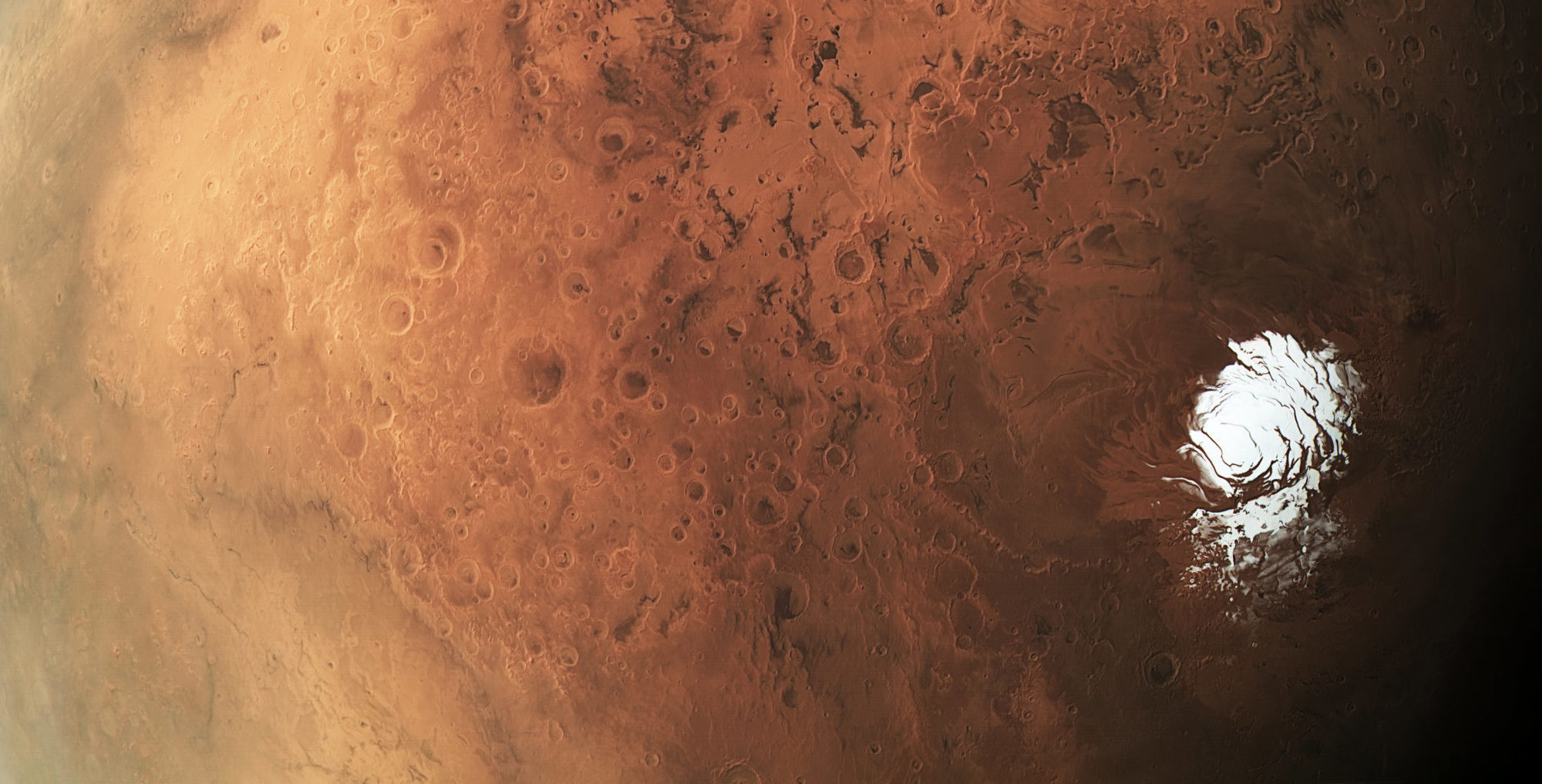Featured image: The south pole of Mars as seen by the HRSC Camera onboard the European Space Agency’s Mars Express mission. Image credit: ESA/DLR/FU Berlin.
Paper: Multiple subglacial water bodies below the south pole of Mars unveiled by new MARSIS data.
Authors: Sebastian Emanuel Lauro, Elena Pettinelli, Graziella Caprarelli, Luca Guallini, Angelo Pio Rossi, Elisabetta Mattei, Barbara Cosciotti, Andrea Cicchetti, Francesco Soldovieri, Marco Cartacci, Federico Di Paolo, Raffaella Noschese and Roberto Orosei.
“Water, water everywhere, but not a drop to drink”- or at least that might be the case beneath the south pole of Mars. In 2018, a team of scientists reported a potential subsurface lake of liquid water 1.5 km beneath the Martian south polar cap. Now, using more observations as well as new analysis methods previously used for ice sheets on Earth, the same team presents new evidence for a large subsurface lake as well as three other lakes in the same area. This raises further questions about how such lakes could be kept liquid in the cold environment of Mars, and whether they could provide a habitable environment for astrobiology.
The new paper, led by Sebastian Emanuel Lauro and recently published in Nature Astronomy, explored a 250 x 300 km2 area known as Ultimi Scopuli—the same area where a potential lake was reported in 2018. The data comes from the Mars Advanced Radar for Subsurface and Ionosphere Sounding (MARSIS) instrument onboard the European Space Agency’s Mars Express orbiter, which uses bursts of radio waves to look at the structure of rocks and ice beneath the surface of Mars. The dataset in the new paper consists of 134 observations taken from 2010 to 2019, compared to the 29 observations used in their 2018 paper. The new data both strengthens the claim of a large subglacial lake roughly 20 x 30 km in size, and suggests the presence of an additional three other smaller underground lakes nearby, each separated by dry ice or rock.
In planetary science, it’s common for researchers to compare what we find elsewhere in the solar system to what we see on Earth, as this helps us ground analysis in something that we can measure more directly than extraterrestrial locations. So not only does this new research use more observations, but the team also makes use of a new analysis technique previously used to detect subglacial lakes on Earth. A new radar detection method, developed to look for lakes beneath the Greenland ice sheet, uses the ‘acuity’ of the radar signal, which is a specific measure of surface roughness. When a high acuity value (indicating a smooth surface) is seen alongside high reflectivity (the strength of the returned radar pulses), it provides a more robust indication of ponded water. This is what Lauro et al. have seen in their investigations of the Mars south polar cap.
It’s still possible that what we’re seeing evidence of is something more like wet sediments, essentially subglacial slush, rather than true lakes of water. However, the Lauro et al. team looked carefully at the interfaces between wet and dry materials, and argue that the reflectivity values are similar to those used to detect subglacial lakes in Greenland, and rise above the threshold for indicating lakes. They also suggest that subglacial lakes could actually be very widespread beneath the south polar cap, although MARSIS is unable to detect them.
Other researchers outside the Lauro et al. research group have suggested that some kind of geothermal activity is needed to heat the water and therefore keep it liquid. Lauro et al. however, argue that geothermal activity isn’t necessary, because recent experiments have shown that certain briny (salty) solutions can stay liquid at temperatures as low as 150 degrees Kelvin, (about -123 degrees Celsius). At the surface of Ultimi Scopuli, the temperature is thought to be roughly 160 degrees Kelvin (~ -113 degrees Celsius), and is expected to increase with depth. The team therefore argues that super salty water could stay liquid without the need for geothermal activity to keep it warm. We already know such salts exist in large quantities on Mars because they have been found by previous missions such as the Phoenix Lander and the Curiosity Rover, so it’s plausible that they could also be in any water beneath the south polar cap.
Why is liquid water beneath the south polar cap on Mars so interesting, if we can’t even drink it? On Earth, subglacial lakes in Antarctica are home to interesting forms of microbial life. Organisms known as extremophiles, able to survive extreme conditions, are known to exist in extremely salty lakes. So, perhaps similar life forms could exist in these lakes on Mars.
Water, but not a drop to drink: multiple salty lakes beneath the south pole of Mars? by Eleni Ravanis is licensed under a Creative Commons Attribution 4.0 International License.

